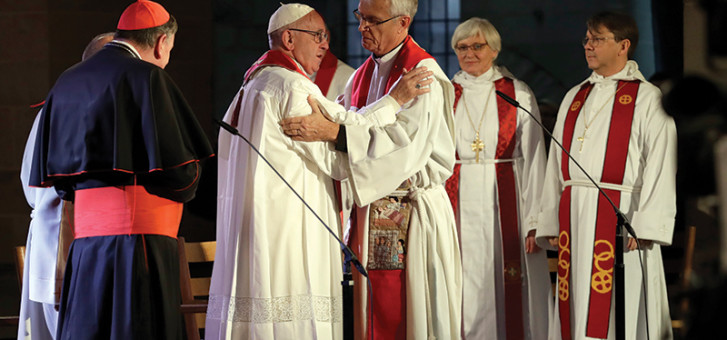Something very interesting is happening as we approach the 500th anniversary of Martin Luther’s 95 theses, which began the Protestant Reformation and the subsequent division of Christianity into many denominations. Inspired by Pope Francis, the South American bishop who was elevated to the Vatican in 2013, many non-Christian leaders are seeking to reconcile their faith communities with Rome.
And as the Reformation began with the separation of Luther from Rome, so the reconciliation is commencing between today’s Lutherans and Rome. A recent document titled “Declaration on the Way: Church, Ministry and Eucharist,” which was signed by both Catholics and Lutherans, confirms that the two groups are committed to reconciliation. As the Lutheran World Federation declared, “To be Lutheran is to be ecumenical. We are committed to the quest for visible unity of the Church. Empowered by Jesus’ prayer in the book of John ‘that all of them may be one . . . so that the world may believe,’ we act as the instrument of Lutheran churches in global ecumenical dialogues. We work to become a better steward of God’s creation in the world together with other Christians. For us, Christian ecumenism is not a choice: it is our mission to witness together with and in Christ, and it is a gift we receive from God through the Holy Spirit.”
Lutherans and Catholics
A significant step toward unity between the Lutheran World Federation and the Roman Catholic Church occurred on October 31, 2016, when the two groups held an ecumenical commemoration of the Reformation in Lund, Sweden. The event was cohosted by the Church of Sweden and the Catholic Diocese of Stockholm, and according to the Lutheran World Federation, “The event highlighted the solid ecumenical developments between Catholics and Lutherans and the joint gifts received through dialogue, particularly in anticipation of the 500th Reformation anniversary in 2017.”
Even evangelicals, many of whom have a long-standing hostility toward and suspicion of the Catholic Church, are warming to Pope Francis and his ecumenical outreach. Catholic magazine Crux reported that “in 2014, during a three-hour long meeting with Texas’ televangelists Kenneth Copeland and James Robison . . . Robison said that he had been so moved by Francis’ message of the gospel that he asked the translator to ask the pope for a high-five. The pope obliged, raised his arm and the two men smacked hands.”
How did we get here? Before the word catholic was used to refer to religion, it was an adjective meaning “universal” or “all-embracing.” It came to be used for the Roman church because, for a long time, the church was indeed well-nigh universal. For more than 1000 years, from the time of the Roman emperor Constantine to the age of the Reformers, virtually all Christians were members of the Roman Church or its Eastern Orthodox daughters.
As the centuries passed, minor differences crept in between the Roman and the Eastern rites and practices, but they still held much in common. Children were baptised by sprinkling as infants, congregants partook of communion blessed by a priest, and so on. The church crowned kings, and in some cases punished them. The church had its own courts and exercised police power, including imprisonment and capital punishment. Rome ruled supreme, dictating doctrine and selling salvation.
A snapshot of history
One wonders why the church that appeared so stable for more than 1000 years began a fragmentation in the 16th century that has continued for 500 years. Externally, the reason may be simple. From its birth at Pentecost until about the year 300, the church was continually under attack from the outside. The book of Acts tells us of martyrdom and persecution, beginning almost immediately after Pentecost. First the Jewish authorities, and later the Romans, oppressed and martyred Christians.
When Emperor Constantine made Christianity the official religion of Rome, he did so largely out of political necessity: Christianity was more popular than he was. But this did not save the church from persecution. It only changed its direction. For by now, the barbarians had begun their centuries-long attacks on Rome, and that meant the church as well.
The Empire fell, but the Roman Church remained. But then, two new persecuting powers arose on the edges of the decaying Roman state: The Vikings in the north and west and Islam in the south and east. The Roman Empire fell in AD 476, and various tribes began consolidating their territories. But the Catholic Church survived and thrived.
Then, in 632, the Muslim advance began, and by 750 Islam ruled from what is modem-day Spain and Portugal in the west, across North Africa, all of Asia Minor and parts of southern Europe, all the way to Persia in the east.
It’s well known that a sense of persecution and danger from outside forces imposes a siege mentality and an artificial sense of unity on any group. And so it was with Christendom. But once the external threat declined, the internal conflicts tore it asunder. Once the Viking and Muslim threats had been blunted, prominent Italian families fought to place one of their own on the throne of Saint Peter, which had become a source of wealth and patronage. The stench of corruption could be sensed in the hinterlands.
The Protestant Reformation
And then a German monk named Martin Luther purposed to cleanse the church. He didn’t want to leave it; he only wanted to reform it. There had been others along the way: Pierre Valdo in France, Wycliffe in England, and Hus and Jerome in Bohemia, yet until Luther arrived on the scene, questions about doctrine were matters for scholars to debate and settled in Rome. But when Luther’s 95 debating points were printed and circulated throughout Europe, Rome’s iron grip began to fail, and that process continued for centuries.
For many of Luther’s 95 topics, there was more than one plausible answer. The arguments over them and their multiple answers spawned even more questions to be fought over. And disagreements over the answers to these questions often led to the formation of new bodies of believers.
As the disputes over doctrine multiplied, so did the number of denominations. Originally, there had been one church, then two. Before long, there were scores. The 2001 edition of the World Christian Encyclopedia listed no fewer than 33,380 Christian denominations!
Now, after half a millennium, Islam is expanding again, and there are increasing calls to reconsolidate, to reunify the church. These developments are not unrelated. Anti-Christian persecution has generated an unintended ecumenical bond. As Francis said, “In some countries they kill Christians for wearing a cross or having a Bible, and before they kill them they do not ask them whether they are Anglican, Lutheran, Catholic or Orthodox.”
But this points to a problem. Ecumenism may be succeeding on a surface level with less open hostility and fewer sermons condemning other Christians, but beneath that tranquil surface, serious conflicts remain. It’s one thing for churches to cooperate in caring for the hungry and homeless—and certainly, these are areas of genuine concern and cooperation for the many faith communities involved. But it’s quite another thing to face the central issues that led to the divisions in the first place.
Ecumenism and unity appear to be two quite different things. A quick rundown of some of the issues that separate faith communities demonstrates this. Are Catholics willing to say that the Bishop of Rome is no longer the heir of Saint Peter and the vicar of Christ? If not, are Lutherans, Methodists, Mennonites and others willing to accept that he is? Is Mary the queen of heaven? Is it appropriate to pray to the saints?
These are just a few of the doctrines where Catholics and Protestants differ. And a long list of others separate Protestants from each other: predestination, baptism, days and modes of worship, the role of women in the church, and increasingly, how to approach questions such as homosexuality and transgenderism. None of these are considered trivial matters; nor are they easily resolved. That’s what led to separation in the first place.
Rupertus Meldenius, an obscure seventeenth century Protestant theologian, came up with the formula for Christian unity: “In essentials, unity; in nonessentials, liberty; in all things, charity.” As the past 500 years have demonstrated, the problem lies in determining which things are essential and which are nonessential. So far, ecumenism has proceeded by ducking these questions.






